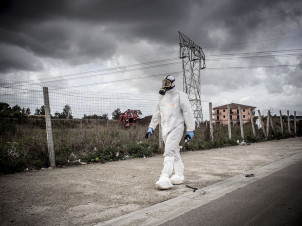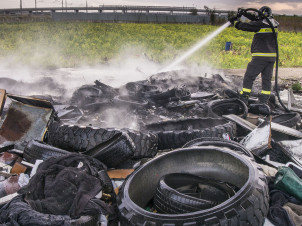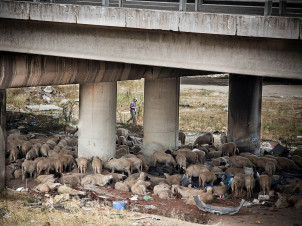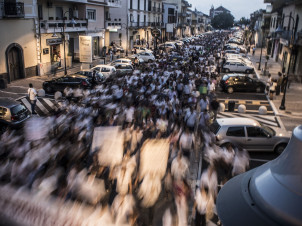
By Salvatore Paolo De Rosa
On the 16th of November, thousands of people are expected to join together in the Southern city of Naples, Italy, during one of the biggest demonstrations organized by the grassroots network that emerged in Campania throughout years of the so-called “waste crisis”. Under the common banners of #Fiumeinpiena (raging river) and #StopBiocidio (end the biocide), the committees and associations from the provinces of Naples and Caserta, together with delegations from other environmental conflicts happening in Italy, will converge in the streets of the region’s capital city to express their “right to life, to health, and to a safe environment”. The demonstrators’ purpose is to bring attention to the ongoing waste-related social and environmental devastation in Campania. They demand that state institutions take action to stop illegal trafficking and wild burning of hazardous waste, and are advocating for the inclusion of local communities in all phases of design and implementation of waste management and land remediation projects in the region. After the march in Naples against the toxic fires on the 26th of October, and after many other local demonstrations in Campania, the “raging river” is now bringing together activists from different municipalities into one single struggle around the health-environment nexus.
The resurgence of the popular mobilizations in Campania has roots in years of confrontation between local communities and waste overflow. Citizens have been organizing for years in an effort to curb the environmental degradation in the region. The heritage of the knowledge and strategies built up so far is the backbone of today’s mobilizations. However, the task confronting them is huge. Over the past two decades, radical and disturbing changes in the landscape over an area of approximately four thousand square kilometres–home to three million people —has been caused by illegal dumping of urban garbage and hazardous waste
Trash is gold
 First, there was illegal trafficking and dumping of toxic waste, carried out by a network of business managers, corrupt public officials, stakeholders, and organized crime. According to police investigations, since the ‘90s, millions of tons of hazardous waste arrived in Campania every year from Northern Italy and Europe, travelling on routes oiled by bribes, and were dumped without the most basic environmental safeguards. Toxic materials from industrial and manufacturing processes, from demolition and digging activities, and even hospital and nuclear waste, were discharged in sand quarries and in unsuitable landfills, buried under agricultural fields of vegetables and fruits, mixed with cement for construction, or just abandoned in the countryside and set on fire. In this dirty business, companies’ desire to get rid of the by-products from their activities at lower costs merged with the predatory economic behaviour of rooted criminal organizations: criminals provided companies with a cheap alternative to correct hazardous waste disposal procedures by simply spreading it in territories under their control. Corruption of local administrators and inspection bodies, political protection, and the lack of credible deterrents by the state, have made this trade one of the main revenues for criminal groups and allowed legal as well as illegal businesses “to socialize the costs of production while privatizing the profits”. Estimates by prosecutors quantify the earnings of organized crime, the companies’ savings and the tax evasions in billions of euros. Essentially, the “Ecomafia” (as it has been labelled by an Italian environmental NGO) represents an important piece of the Italian shadow economy. As a former mafia affiliate that turned his back to his fellows said: the trash, in their hands, becomes gold.
First, there was illegal trafficking and dumping of toxic waste, carried out by a network of business managers, corrupt public officials, stakeholders, and organized crime. According to police investigations, since the ‘90s, millions of tons of hazardous waste arrived in Campania every year from Northern Italy and Europe, travelling on routes oiled by bribes, and were dumped without the most basic environmental safeguards. Toxic materials from industrial and manufacturing processes, from demolition and digging activities, and even hospital and nuclear waste, were discharged in sand quarries and in unsuitable landfills, buried under agricultural fields of vegetables and fruits, mixed with cement for construction, or just abandoned in the countryside and set on fire. In this dirty business, companies’ desire to get rid of the by-products from their activities at lower costs merged with the predatory economic behaviour of rooted criminal organizations: criminals provided companies with a cheap alternative to correct hazardous waste disposal procedures by simply spreading it in territories under their control. Corruption of local administrators and inspection bodies, political protection, and the lack of credible deterrents by the state, have made this trade one of the main revenues for criminal groups and allowed legal as well as illegal businesses “to socialize the costs of production while privatizing the profits”. Estimates by prosecutors quantify the earnings of organized crime, the companies’ savings and the tax evasions in billions of euros. Essentially, the “Ecomafia” (as it has been labelled by an Italian environmental NGO) represents an important piece of the Italian shadow economy. As a former mafia affiliate that turned his back to his fellows said: the trash, in their hands, becomes gold.
Endless emergency
Alongside and intertwined with the flows of waste entering through illegal channels, the officially declared “urban waste emergency” has held Campania in the grip of centralized special powers and non-transparent procedures of public administration for the management of municipal garbage for fifteen years. In 1994, the Italian government declared a “state of emergency” in Campania due to the waste crisis. The looming prospect of saturated landfills and the lack of trash-processing facilities in the region were addressed by the state with the creation of a special government agency which held the power to deviate from ordinary laws and granted huge public funds that lacked strict accountability. The techno-managerial approach displayed by the agency resulted in the privatization of the urban waste sector and in the exclusion of local communities from decision-making processes. The task of designing and carrying out the waste management was entrusted to an association of Italian and German enterprises that centred their plans on waste-processing facilities, waste-to-energy plants and landfills. In their plans, they disregarded any attempt to reduce and recycle garbage. Putting the plan into action entailed the dispossession of municipal lands for the use of private companies and the financialization of waste as a revenue guarantee for the banks loaning money. The main interest of the enterprises turned out to be the processing and accumulation of as much trash as possible, in order to subsequently burn it in the waste-to-energy plants and collect public subsidies from the electricity thus produced. In fact, a favourable decree by the government assigned the electricity produced from burning trash as eligible for subsidies in the framework of renewable energies, incentives, in contravention of EU practices. Furthermore, the mismanagement led to recurrent flooding of trash and to the necessity of finding new areas to store the waste. This led to the establishment of enormous storage sites of waste processed into refused derived fuel, that are still standing today. The Taverna del Re storage site near Giugliano, for example, represents the acme of this policy: 130 hectares of land filled with more than five million tons of rotting waste blocks piled up amidst cultivated fields.
Faced with the abuses of the special agency and with the protracted mismanagement of urban waste, the mistrust of local populations increased dramatically. The steady opposition of local communities to top-down solutions was dealt with by the central government in 2008 with the militarization of waste facilities and through the criminalization of any act of protest. The “waste emergency” has morphed, as some have argued, into a “crisis of democracy”. The turn to authoritarianism did not solve the deadlock. It only provided legal grounds for the opening and re-opening of landfills for which remediation was planned and for further repressing local concerns with increased police force and repression. We know today that several times during the 1994-2009 emergency, the stoppage of facilities was arranged by the companies so as to pressure the government for more resources and more law derogations. Besides that, the regime of emergency has offered a veil to the trash traffickers for hiding hazardous waste under the category of urban waste. In some cases, the same economic interests provided their services both to the state and to the criminal organizations arranging the traffic. In February 2011, the European Parliament issued a resolution that condemned the actions taken by the Italian government for managing waste in Campania, highlighting the failure, the squandering of money, and the authoritarianism of the public institutions during the years of special powers. Finally, in its assessment of the waste emergency era in Campania, the Parliamentary Commission on Illegal Activities Related to the Waste Cycle (2013) is quite straightforward and clear: “We can certainly say that the administrative apparatus has favoured substantially illicit interests. It is evident that the system, at this point, appears to have been reprogrammed so to operate as a machine capable certainly of producing profits, but not solving the problems, because solving the problems would obviously stop any possibility of making profits with the waste cycle”.
Biocide
 The environmental outcomes of this economy of contamination have slowly shown their magnitude. According to surveys of the Campania Regional Agency for Environmental Protection (ARPAC) in 2008, there are at least 3000 contaminated sites in all of Campania, with the majority of them clustered in the area between Naples and Caserta. The pollutants present in these sites are mostly due to urban and industrial waste that has been incorrectly disposed of. Recent excavations in the southern countryside of Naples, carried out by the ARPAC and the forest police under the pressure of popular mobilizations, have unburied several underground illegal deposits of barrels containing chemical solvents and industrial waste, which has been in dangerous contact for years with the aquifers that supply water to cultivated fields. A 2012 geological analysis, commissioned for assessing the magnitude of contamination under an illegal dump in Giugliano, ends with an apocalyptical forecast: by 2064 human life will be impossible in a range of twenty kilometres from this dump. This analysis and other available evidence testify to the severe impairment of the environmental conditions in a number of places in Campania, a situation synthesized by the terms “Triangle of Death” and “Land of Fires” that have appeared in academic publications and the national press. This environmental degradation is clearly an established risk in terms of health for the residents. A profusion of scientific studies have connected the rising rates of cancer diseases, fetal malformations, and rare tumours among the population of these areas to the presence of dioxins, PCB, heavy metals and other chemicals leaked from the waste into the local biota and food chain. Popular epidemiology records also signal increasing health impairments that, by now, have transformed into a generalized fear. Researcher Antonio Giordano coined the term Biocidio (biocide) to describe this intersection of waste, business, environmental destruction and growing cancer disease. Biocidio is the systematic violation of the right to health through poisoning of the environment and the consequential exposure of the population to pollutants. In Campania, it means a whole ecosystem has been sacrificed to narrow interests and greed by an apparatus of politicians, entrepreneurs and criminal groups that have turned the region into the “biggest open-air laboratory of carcinogenesis in Europe”.
The environmental outcomes of this economy of contamination have slowly shown their magnitude. According to surveys of the Campania Regional Agency for Environmental Protection (ARPAC) in 2008, there are at least 3000 contaminated sites in all of Campania, with the majority of them clustered in the area between Naples and Caserta. The pollutants present in these sites are mostly due to urban and industrial waste that has been incorrectly disposed of. Recent excavations in the southern countryside of Naples, carried out by the ARPAC and the forest police under the pressure of popular mobilizations, have unburied several underground illegal deposits of barrels containing chemical solvents and industrial waste, which has been in dangerous contact for years with the aquifers that supply water to cultivated fields. A 2012 geological analysis, commissioned for assessing the magnitude of contamination under an illegal dump in Giugliano, ends with an apocalyptical forecast: by 2064 human life will be impossible in a range of twenty kilometres from this dump. This analysis and other available evidence testify to the severe impairment of the environmental conditions in a number of places in Campania, a situation synthesized by the terms “Triangle of Death” and “Land of Fires” that have appeared in academic publications and the national press. This environmental degradation is clearly an established risk in terms of health for the residents. A profusion of scientific studies have connected the rising rates of cancer diseases, fetal malformations, and rare tumours among the population of these areas to the presence of dioxins, PCB, heavy metals and other chemicals leaked from the waste into the local biota and food chain. Popular epidemiology records also signal increasing health impairments that, by now, have transformed into a generalized fear. Researcher Antonio Giordano coined the term Biocidio (biocide) to describe this intersection of waste, business, environmental destruction and growing cancer disease. Biocidio is the systematic violation of the right to health through poisoning of the environment and the consequential exposure of the population to pollutants. In Campania, it means a whole ecosystem has been sacrificed to narrow interests and greed by an apparatus of politicians, entrepreneurs and criminal groups that have turned the region into the “biggest open-air laboratory of carcinogenesis in Europe”.
Grassroots arise
The resistance deployed by local communities throughout years of continuous environmental destruction is the basis from which the social movements of Campania are mobilizing today. Over more than ten years, grassroots committees and associations have emerged primarily as local efforts to defend their livelihoods. Belonging to the municipalities targeted by the government waste management policies and/or living in areas affected by the illegal waste-related business, these citizen groups oppose the localization of landfills and incinerators on their territories and vehemently denounce the illegal dumping. Meanwhile, the people from the surrounding areas of Naples and from the agricultural towns of the plain besieged by the trash are uniting to defend their health: they are farmers, shepherds, ordinary citizens, doctors, local churches, political activists and, on the forefront, the women. They rarely call themselves environmentalists: the threats to the environment are rather perceived as a personal issue. The evidence of contamination brought people to the streets; it led them to politicize waste, science, and ecology and to expose the power dimensions in their cities and environment. They fought and proposed alternatives, filed lawsuits and produced counter-information, put their bodies on the frontlines when everything else failed. Major clashes have occurred in Acerra (2004), Chiaiano and Pianura (2008), and Terzigno (2010); the struggle at some points became harsh, including guerrilla actions and road-blocks which continued for days. Committees born in the wake of a single protest became permanent political subjects, improving connections with other movements that engaged across several scales in the defence of territories and against authoritarian development projects and exploitation. Groups in Campania created pacts of mutual assistance with national and global networks that have nurtured circuits of knowledge exchanges in which experts and activists cooperate to challenge the epistemological foundations of the waste plans. Most of all, the experience of mobilization has resonated in many grassroots projects aimed at the revitalization and valorisation of the territories, beyond the waste crisis.
The physical repression deployed by the state has increased and at the same time has added fuel to the resistance over the last years. Besides violence, the delegitimization of the movement has been built and reinforced through enduring stereotypes, going as far as blaming Campania people’s lifestyle as the main cause of their cancer diseases. Such criminalisation of activists and communities in protest has resulted in the organized mafia gaining more and more ground and expanding the areas of illegal dumping of toxic waste.
Reclaiming commons
 But things are changing. The incredible amount of experience, knowledge, skills and the network capacity of today’s social movements in Campania makes it much more difficult to crash, dismiss or co-opt the mobilization. Activists now have their own media, based on social networks, neighbourhood TV and citizen journalism, which compete with the traditional mass media and often set the agenda. Arts, music and flash mob performances continue to nourish this social awakening, producing transfigurations of the ecological death and rebirth that appear suddenly in the streets and become viral through virtual channels. Almost every municipality between Naples and Caserta has a local committee that will flow immediately into the raging river. On the 16th of November, #16Nov, the demands are common and non-negotiable: end of the illegal waste trafficking; proper monitoring of the poisoned lands and contaminated water sources; protection and promotion of non-polluted agriculture; remediation of land through ecological means in cooperation with local committees and farmers; and implementation of participatory approaches to urban planning, waste management and development projects. Vigilance must ensure that untrustworthy institutions are no longer able to transform the legitimate demands for land reclamation into yet another “state of emergency”— a situation in which public resources are used to bypass controls and formal procedures to grease the wheels to the next legalized looting in the name of the “civic good”. But Campania’s people are experienced now, and they are becoming stronger by sharing practices and networking
But things are changing. The incredible amount of experience, knowledge, skills and the network capacity of today’s social movements in Campania makes it much more difficult to crash, dismiss or co-opt the mobilization. Activists now have their own media, based on social networks, neighbourhood TV and citizen journalism, which compete with the traditional mass media and often set the agenda. Arts, music and flash mob performances continue to nourish this social awakening, producing transfigurations of the ecological death and rebirth that appear suddenly in the streets and become viral through virtual channels. Almost every municipality between Naples and Caserta has a local committee that will flow immediately into the raging river. On the 16th of November, #16Nov, the demands are common and non-negotiable: end of the illegal waste trafficking; proper monitoring of the poisoned lands and contaminated water sources; protection and promotion of non-polluted agriculture; remediation of land through ecological means in cooperation with local committees and farmers; and implementation of participatory approaches to urban planning, waste management and development projects. Vigilance must ensure that untrustworthy institutions are no longer able to transform the legitimate demands for land reclamation into yet another “state of emergency”— a situation in which public resources are used to bypass controls and formal procedures to grease the wheels to the next legalized looting in the name of the “civic good”. But Campania’s people are experienced now, and they are becoming stronger by sharing practices and networking
The cooperation among diversities, that the core of the mobilization maintains, has developed into a common platform that advocates popular control of the environment, beyond waste and beyond Campania. This has created fertile ground for connections with communities elsewhere in Italy engaged in the struggle against the same economic model that extracts profits from environmental destruction and health damages. A coalition of social forces is growing, becoming part of a geography of violations and resistance throughout the national territory. On the 16th of November, committees from Lazio, where polluting plants, landfills and waste trafficking are making life unbearable for its residents, will join the demonstration in Naples. In the same day, the NoTav campaigners against the high-speed railway megaproject will march in the Northern Susa valley against the project and the repression of local communities; in Pisa, occupiers of the Municipio dei Beni Comuni/Ex Colorificio Rebeldia, a community space that has become a local landmark for claiming the right to have common spaces for community activities, will march in the city to attempt to stop the eviction by the state authorities.
There are finally two banners under which this new season of social mobilization in Italy is articulating: Stop Biocidio — for ending the exploitation of people and ecosystems; and Beni Comuni — the commons, for reappropriating the shared means of production and reproduction and place them under community control, for the inclusion of diversity, present and future generations, and the environment in an egalitarian space of democratic politics.
Images courtesy of Mauro Pagnano.

The project ENVJUSTICE has received funding from the European Research Council (ERC) under the European Union’s Horizon 2020 research and innovation programme (grant agreement No. 695446)